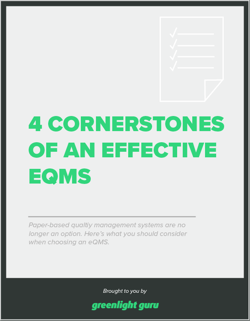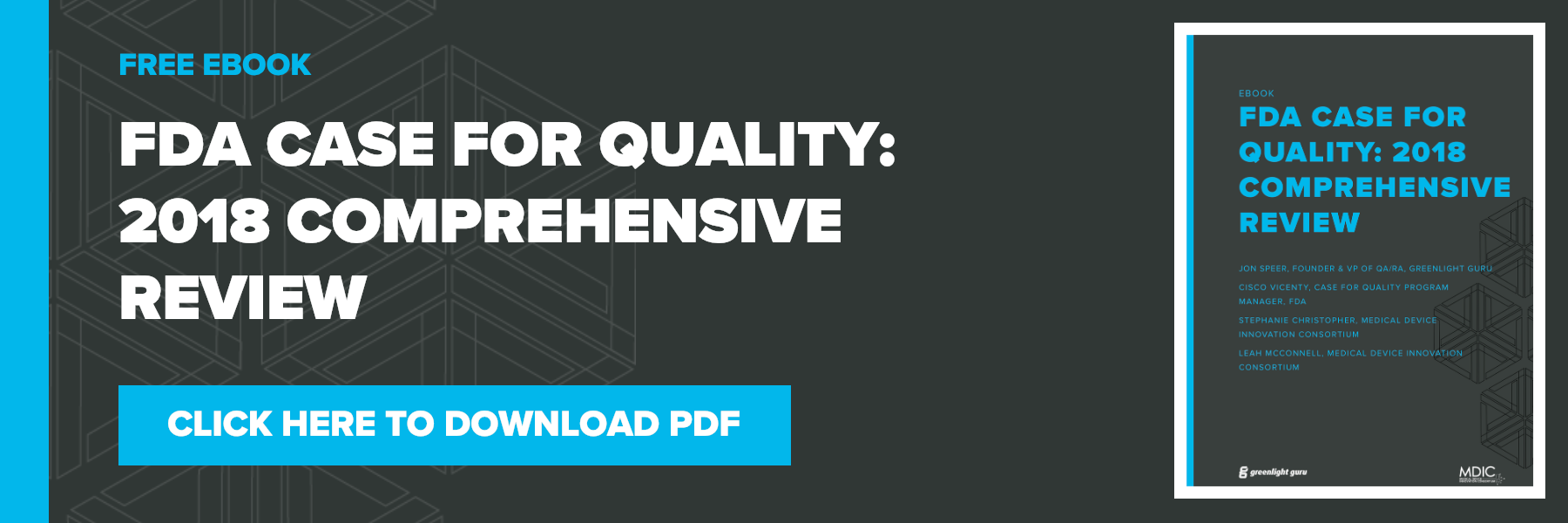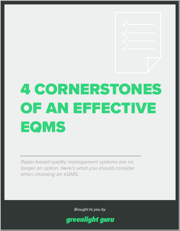
If you’re going through a growth phase, it’s important to consider how you’re going to approach regulatory and quality as your company scales. I recently caught up with Mike Drues of Vascular Sciences to discuss just that. What should you be doing throughout the process?
Download Our Free Resource: 4 Cornerstones of an Effective eQMS.
Working with regulatory agencies
It’s not just the company size in terms of employees that matters anymore. With the increased use of outsourcing, the company scope is actually much greater than its headcount. We used to almost exclusively gauge a company size by its number of employees; however, due to third-party resources, it's common for a company to have several products on the market without a large number of employees.
Roughly 80% of medical device companies have less than 50 employees. This is a big difference between the medical device industry and the pharmaceutical industry. In some cases, some medical device companies consist of a few people working in someone’s garage. A lot of cool, innovative ideas come from these small, agile companies.
Perhaps the transition from small to large is more of a mindset, given this background. But regardless of size, the transition of new approaches to QMS and Quality needs to be managed well.
Regulatory agencies don’t distinguish how they look at a small company versus a large one. Whether you have 2 or 200 employees, theoretically, you're all treated the same in how you're regulated by these agencies.
One thing we will say is that the first communication you have with the agency as a new and/or small company is critical in terms of setting a baseline. The first impression really does matter. On the other hand, if you’re working for a well-established company, it may be less important to manage your impression with them as they have a history with you.
It’s happened a number of times when someone moves from a large company to a small one, they naturally become very conscious about establishing that first interaction. The pre-submission program is a great way to establish that baseline with the FDA because it helps develop that first impression of you. Even if you don’t go through pre-submission, making some kind of early engagement with the FDA is important to get the relationship established.
Today’s FDA is very interested in collaborating with medical device companies, instead of only playing the role of regulator. It’s important to consider the relationship your company has, and remember they are real people too!
Cleaning up a first impression mess
If you have made a “suboptimal” first impression with the FDA, it's not the end of the world. A huge part of Mike’s role involves coming into a company and cleaning up a mess someone else made. They go into damage-control mode with the FDA, explaining there’s a “new game in town” and they’re looking to restart with a clean slate.
The point is, if you’re already reading this and questioning your own company’s first impression with the FDA, it’s not too late. It is possible to show them that you have a plan and you’re serious about improving whatever it was that was at the base of that negative impression.
Right-size your QMS
What sort of behaviors or mindset is expected of more developed companies as compared to startups? Well, there’s a good case to be made that if you start out with the right mindset in place, nothing really needs to change.
Having a QMS and design controls in place is a great start. Many small companies aren't keen on the paperwork associated, and their eyes tend to glaze over at the thought. It may not be necessary to have a full-sized system in place, but the things you do while still small in size can make it much easier to transition later.
One of the big things I talk about is that, while a quality system should be top of mind for medical device companies, it’s important to “right size” your QMS. It should reflect the current size and stage of your company. Once you get to manufacturing and launching your product, your QMS should also evolve to supplement that growth.
There are varying levels of QMS and it's not a one-size fits all solution. When you begin, it’s fine to have just the basics in place (design controls and risk management are musts). As long as your QMS grows with you to cover your testing, including more formalized procedures, you should be in a good position for success when it comes to regulatory standards.
Another thing to consider is whether your company is looking for investors or to be acquired. Having your regulatory and quality practices formalized makes you more attractive to potential buyers or investors. If the company is doing what they should be doing and documenting what they should be documenting, it can always be properly formatted later. The key is capturing the content from start to finish. Try not to get hung up on where you should be putting it.
The intent behind what you’re doing is important too, so always remember to document your rationale and adhere to “prudent engineering” practices. Mike often has to even remind people with considerable industry experience, including FDA officials, not to become so hyper-focused on forms that they lose track of the bigger picture. The biggest question you should focus your efforts on is being able to answer 'yes' to the question, is the content there?
Measure your system effectiveness
I've been at companies where a web of complications was created when it came to regulatory. For instance, they assign CAPAs for everything, then end up with an impossible list of procedures to get through. It’s easy for that situation to snowball and lead to problems with the FDA and other regulatory agencies.
If a company finds themselves in a situation where there is a mess to clean up, they should always fall back to prudent engineering. Regulatory logic should remain the same, no matter the size of the company.
All companies are required to have a QMS in place that meets regulatory requirements, but we never assume that the QMS actually works for them. How often do you hear of people measuring the efficacy of their system? Mike has suggested to companies that they deliberately inject a problem somewhere to see whether their system can manage it. If the system doesn’t work, then it's probably a huge waste of time and money.
Download Our Free Resource: 4 Cornerstones of an Effective eQMS.
Final thoughts
Regardless of how you operate your quality and regulatory systems, it is the content that should drive the ship. No matter how you start out with your regulatory and quality procedures, remember this key tip.
You don’t have to begin with a huge, multifaceted QMS; in fact, this can overcomplicate the process for startups and lead to procrastination with actually implementing a quality system. I encourage you to consider the idea of a “right size QMS” as an ally that will grow with your company and strengthen the regulatory and quality practices of your team.
For a reliable, scalable eQMS, check out Greenlight Guru here and request a demo.
Jon Speer is a medical device expert with over 20 years of industry experience. Jon knows the best medical device companies in the world use quality as an accelerator. That's why he created Greenlight Guru to help companies move beyond compliance to True Quality.
Related Posts
How to Switch to eQMS Software When You're Just Using Paper
What it Means to be Focused on Quality vs. Compliance
[VIDEO] 4 Medical Device Manufacturing Best Practices for a Successful Design Transfer (Approve Phase)
Get your free resource
4 Cornerstones of an Effective eQMS












